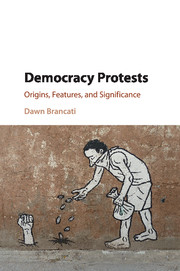Book contents
- Frontmatter
- Dedication
- Contents
- List of Figures
- List of Tables
- Acknowledgments
- 1 Introduction
- 2 Characteristics of Democracy Protests
- 3 Relating Economic Crises to Democracy
- 4 Analyzing the Rise of Democracy Protests
- 5 Analyzing Elections as Trigger Events
- 6 Historical Trends in Government Responses
- 7 Analyzing Political Accommodation
- 8 Historical Trends in Democratization
- 9 Analyzing Democratization
- 10 Conclusion
- Appendix: Data and Measures
- References
- Index
8 - Historical Trends in Democratization
Published online by Cambridge University Press: 05 September 2016
- Frontmatter
- Dedication
- Contents
- List of Figures
- List of Tables
- Acknowledgments
- 1 Introduction
- 2 Characteristics of Democracy Protests
- 3 Relating Economic Crises to Democracy
- 4 Analyzing the Rise of Democracy Protests
- 5 Analyzing Elections as Trigger Events
- 6 Historical Trends in Government Responses
- 7 Analyzing Political Accommodation
- 8 Historical Trends in Democratization
- 9 Analyzing Democratization
- 10 Conclusion
- Appendix: Data and Measures
- References
- Index
Summary
Whether or not governments directly accommodate democracy protests either by making political concessions to them or by stepping down from power, provides valuable insights into the influence of these protests, but there is still much more to learn about their import. In some cases, these actions can either entail or trigger further concessions that result in major democratic reforms. In others, they may simply maintain the status quo because they either only repel threats to democracy or are of minor significance even when fully implemented. Still in other cases, the protests can deepen democracy in the long-term, even if they do not result in concessions in the immediate-term, by leading governments to initiate reforms in the future in order to forestall further protests. The converse can also be true, however. That is, governments can make significant concessions in the short-term in order to quell democracy protests and repel international pressure for reform, but subsequently backtrack on these reforms, and restrict democracy even further.
For this reason, in this chapter, I examine qualitatively the changes that occur in the level of democracy in countries within one year of democracy protests, and the relationship of these changes to the concessions governments made in response to the protests, as well as the context surrounding them, in order to determine the extent to which the protests likely contributed to these democratic changes, and why. While the effects of democracy protests may reverberate beyond a year, or alternatively may not even be visible until after a year, the analysis focuses on a year because it is difficult to link political changes to any democracy protests outside of this time frame. The analysis also examines whether or not changes observed within a year last at least two. The relationship between the protests and these changes in democracy is analyzed statistically in the subsequent chapter.
DEMOCRATIZATION
Democratization is a broad term that I use to refer to any improvement in democracy within or across regimes. It encompasses both democratic transitions and democratic reforms. I measure democratization in terms of the polity index because the coding criterion of this index is closely aligned with the way in which I define and measure democracy protests.
- Type
- Chapter
- Information
- Democracy ProtestsOrigins, Features, and Significance, pp. 144 - 158Publisher: Cambridge University PressPrint publication year: 2016



